Seaside Serenade Newport Hydrangea
At the Cultivate'20 Virtual event, many branding companies are introducing new cultivars. I figured I would pick up in this newsletter where I left off in the last one—commenting on a Monrovia hydrangea introduction.
Last time, I spoke about the Seaside Serenade Cape Hatteras Hydrangea in a tribute to my upcoming vacation to, you guessed it, Cape Hatteras, North Carolina. Now that I'm back home in sweltering Georgia, I want to go back.
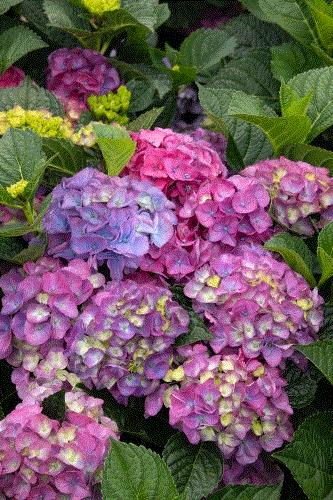
But I digress … so let’s get back to Monrovia’s newest introduction to the Seaside Serenade Collection. Newport Hydrangea, like its siblings, features exceptionally strong stems that don't flop in windy or rainy weather. This quality also ensures the blossoms hold up longer when cut for flower arrangements.
Newport reblooms from early summer until autumn and offers a compact habit, allowing it to fit in both large- and small-space landscapes. This mophead hydrangea features striking flower heads that are a deep-plum in acidic soils or a vibrant pink in more alkaline soils (but don’t expect any blue from it). Hardy in Zones 4 to 9, it reaches a rounded 4 ft. at maturity.

The Science of Southern Gardens
This should be a fun webinar and not only because I will be one of the speakers. In fact, this event will include some outstanding speakers from universities across the southern U.S. that will cover a wide variety of topics that hopefully will keep your interest up and your butt in your chair!
"The Science of Southern Gardens" will explore the plants from the past to the flowers of the future. Faculty with the USDA and Southern Land Grant Universities will deliver engaging presentations about plants, pests, adaptability and breeding from our founding fathers to the future!
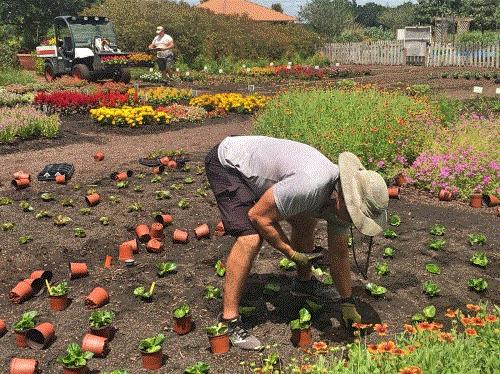
WHEN: Friday, August 7, 2020 from 8:45 a.m. - 12:30 p.m.
WHERE: Virtual via Zoom Webinar (Register Here)
Agenda
-
8:45 - 9:00 a.m.: Welcome & Introductions—Hannah Wooten, UF/IFAS Extension Orange County, Commercial Horticulture
-
9:00 - 9:30 a.m.: Crapemyrtle Bark Scale: Be on the Lookout!—Mengmeng Gu, Texas A&M University
-
9:30 - 10:00 a.m.: Breeding New Ornamental Plants at the U.S. National Arboretum—Lisa Alexander, U.S. National Arboretum
-
10:00 - 10:30 a.m.: Rose Rosette and Other Diseases Threaten Florida Roses—Gary Knox, UF/IFAS- NFREC
-
10:30 - 11:00 a.m.: Plants that Have Survived the Test of Time … from Thomas Jefferson to Your Landscape—Matthew Chappell, University of Georgia
-
11:00 - 11:30 a.m.: Animal Compost Substrate Research at University of Kentucky—Win Dunwell, University of Kentucky
-
11:30 - 12:00 p.m.: Climate Change Impacts on Plant Development and Specification for Sustainable 21st Century Built Environments—Mike Arnold, Texas A&M University
-
12:00 - 12:30 p.m.: All America Selections Winners and Other Outstanding Plants in the South Mississippi Branch Experiment Station Trial Garden—Patricia Knight, Mississippi State University

Event Updates
Every newsletter, there seems to be a few more tradeshow/event notifications. This newsletter is no different. Of particular note this time, the spoga+gafa 2020 has been rescheduled for May 30 - June 1, 2021 in Cologne.
From the event organizers: "Despite high registration levels in the spring of this year and extensive preparations, the current COVID situation has caused strong health, safety, economic and travel concerns among many of our registered exhibitors and visitors. As the health and safety of our customers is of outmost importance to us, we reassessed the overall situation and made the decision to respond to the wishes of the majority of our exhibitors and visitors not to go forward with Orgatec 2020.
"This was a very difficult decision for us since we were fully prepared to conduct this event under well-thought-out and renewed safety standards. At the request of the industry, we have also permanently moved the date for spoga+gafa to the first half of the year. In future, this means that the fair will be held at a time more convenient for orders by large segments of the industry."
In addition, The Georgia Green Industry Association’s WinterGreen Trade Show has been transitioned from an in-person to 100% online event (both trade show and educational tracks). According to GGIA, the virtual trade show will be held on January 19-21, 2021, with educational programming likely having a longer window of availability. GGIA will release the finalized details once they're established. Continue to save the date for WinterGreen 2021!
Last, but not least, I erroneously reported that MANTS 2021 was in a "Save-the-Date" mode in the last newsletter. In fact—the folks at MANTS are still in go mode and are hopeful that the conference will happen as planned. Vanessa Finney sent me a message indicating that: “We (at MANTS) are full steam ahead and optimistic that we will be able to host an in-person show this coming January.”
So don’t go counting MANTS out yet. Of course, Vanessa and her staff are constantly monitoring the landscape (pun intended) and they always have the clients’ best interest in mind. Yet it’s nice to see one show holding out hope for January.

University of Florida Releases Irrigation Scale Videos
When it comes to irrigation, simple is better so that workers don’t have to think too hard when making a decision. That’s why I like the new University of Florida videos that introduce a simplistic irrigation decision-making tool that’s based on a 1 to 5 scale.
Communication on when and how much to irrigate is critical in the production of high-quality, uniform plants. The University of Florida IFAS Extension has developed short and simple videos in English and Spanish (“The 1 to 5 Moisture Scale for Container Substrates”/“La Escala de Humedad de 1 a 5 para Sustratos de Macetas”) on its YouTube channel (tinyurl.com/UFGTO) that define the 1 to 5 moisture scale used to manage irrigation of container plants.
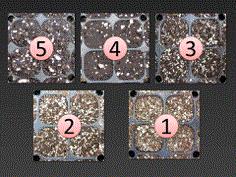
One of the most challenging aspects in irrigation management is to communicate when and how much to water. How do you define how wet is wet and how dry is dry? Having a standardized moisture scale that's easy to understand and use will benefit the entire greenhouse team.
This video was produced in conjunction with Dr. Ryan Dickson at the University of Arkansas, with Spanish language support from Javier López of Altman Plants. Get your whole growing team involved using moisture levels and everyone can contribute to the future success of your crop.
The videos are training materials in the Greenhouse Training Online courses for growers in greenhouse management, including Nutrient Management 1 (Introduction), which began July 6, 2020 (hort.ifas.ufl.edu/training). More videos are set to be released in the coming weeks.

Caryopteris Beekeeper
Bloomin’ Easy is a brand that's definitely gotten my attention as a leader when it comes to releasing successful cultivars. These folks don’t throw darts at a wall, but rather release plants capable of wide adaptability and that perform as promised. I appreciate that as a plant breeder and always look forward to their new introductions.
This year at Cultivate’20 Virtual, they've introduced four new cultivars. While they're all impressive, I'm drawn to one aptly named cultivar in particular.
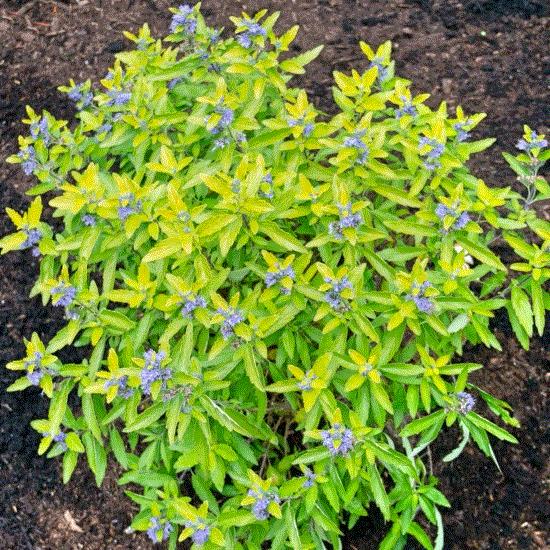
Caryopteris Beekeeper is in fact a heck of a pollinator plant and this cultivar adds a striking foliage color to an outstanding blue flower color. When sited in full to part sun in Zones 5 to 9, it reaches a mature rounded size of 2 to 3 ft. Being on the smaller size for a Caryopteris xclandonensis, it makes a good landscape (especially a second-level planting) or container plant. I personally can’t wait to grab one for myself!
Spring 2020: The Final Score
I enjoy following my bossman’s (Chris Beytes’) weekly spring sales survey. Hence, I bring you his final recap of the season. I say recap, even though it seems sales keep on rocking!
The results of this wild spring are in and they’re impressive, as you might expect: The U.S. scored 8.1, while Canada scored 8.2. That’s based on 988 scores over 12 weekends. In comparison, Spring 2019 was nearly a full point lower: 7.3 in the U.S. and 7.2 in Canada. Spring 2018 scored a much-worse 6.7/6.7, 2017 was 7.0/5.9, 2016 was 7.1/7.6, 2015 was 6.9/6.6 and 2014 was 6.7/6.5. In other words, Spring 2019 was by far the best in the past seven years.
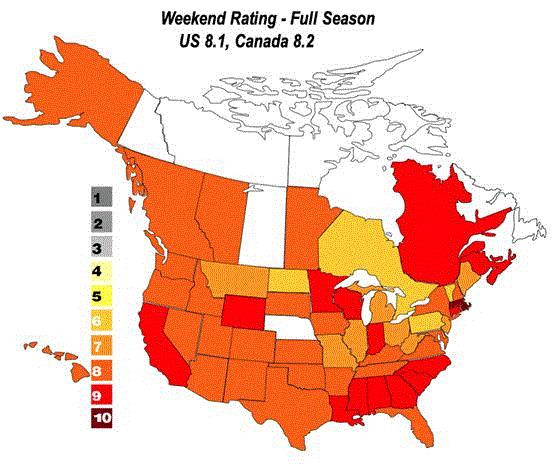
Broken down by month, April started out pretty typical, at 6.8 in the U.S. and 6.8 in Canada. May is when it exploded, at 9.1/9.0. Nearly as good and a lot better than normal was June, at 8.3/8.8.
Let’s take a look by region, here and in Canada:
Regions:
West 8.6
South 8.3
Midwest 8.1
Mountain 8.1
Northwest 8.1
Plains 8.0
New England 7.7
East 7.5
The leading regions, West and South, had two advantages: good weather early (which stayed good!) and no hard outbreak of COVID to contend with. That led to consistently strong scores almost every weekend of spring.
Canada:
Quebec 9.6
Atlantic region 9.3
British Columbia 8.8
Alberta 8.1
Manitoba 8.1
Ontario 6.8
In Canada, everyone did well except Ontario, which got off to a late start due to a long lockdown. Once it broke for them, they really took off, however, so I think that 6.8 doesn’t reflect how good it actually was in Ontario.
Top 10 states:
Wyoming 9.2
Alabama 9.1
Minnesota 9.1
Indiana 9.0
Louisiana 9.0
North Carolina 9.0
California 8.9
Mississippi 8.9
South Carolina 8.9
Wisconsin 8.8
No particular rhyme or reason about why any of these states scored so high other than consistently good weather and a relatively light reaction to the pandemic by state authorities. Note that they cover the country from Alabama to California, Louisiana to Minnesota. Usually you get one region that just gets hammered by bad weather in May or June. This year it never happened.
Bottom 10 states:
Pennsylvania 5.7
Vermont 6.3
North Dakota 6.4
Maine 6.6
Michigan 6.7
New Jersey 6.7
West Virginia 7.0
Montana 7.3
Delaware 7.4
Illinois 7.4
Missouri 7.4
In the case of a few of these states, namely Pennsylvania, Michigan and New Jersey, you can blame the low scores directly on COVID and how delayed their openings were. In the others, such as my own Illinois, it was more about a late start to spring—really until after Mother’s Day Weekend (which was rainy). Once it broke for those states, it was great, and chances are good businesses made up in late May and June for lost sales in April and May. I know plenty of growers and retailers that were behind plan in May and ahead in June.

Notes from the Edge of Sanity
I just (two days ago) returned from my first real vacation in three years. Yes, I'm a workaholic. BUT—two weeks spent on an island and not paying attention to email or voicemails or the news was just what I needed. I bet it’s what many of you need right about now, too.
The question I spent a lot of time contemplating while vacationing in Hatteras, North Carolina, was, “Why don’t I do this more often?" A darn good question and one that there's no good answer for, other than I'm overscheduled and literally (in my mind) too busy to take a break.
However, a psycharist friend of mine was actually the reason why I scheduled this vacation way back at Christmas. She told me that the easiest way for a workaholic person to actually take (and enjoy) a vacation was to schedule it at least six months in advance. In doing so, we workaholics can work through the stages of accepting that we'll be away and we can prepare those around us for life without us.
Turns out, that’s absolutely correct! Everyone around me knew I was going to be away and they all lived through my vacation! Shocking, you may say, that a professor wasn’t missed for two weeks! In fact, when I returned, it seemed that no one even missed me. Maybe I have a false assumption that I'm more important than I really am.
You may be making that same assumption. Plan a vacation … recharge … and relax more. It will make you a happier and more productive person.
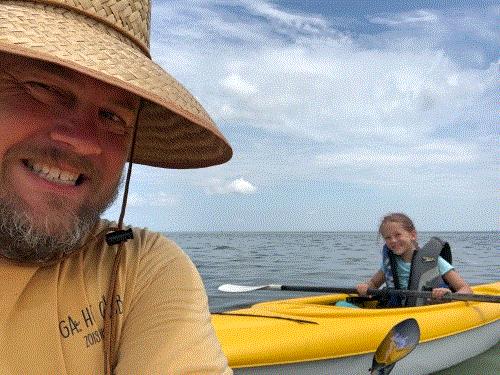
NOTE: You can vacation and still adhere to CDC guidelines related to COVID-19 and social distancing. So don’t get upset at the message—just be intelligent in how you interact with others. It also helps your sanity to put your 8-year-old kid in another kayak!


Live authentic,

Matthew Chappell
Editor-at-Large
Nursery & Landscape Insider
This has been received by 27,798 of the hardest-working horticulturists in show business!
If you're interested in reaching 27,798 (and growing) clients who eagerly await every Nursery & Landscape Insider and surely read every word, contact Kim Brown ASAP and she'll hook you up.